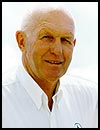
Famous Australian Racer Frank Gardner who spent a bigger part of his race career in Europe
Frank Gardners Trans Am History and a few more insights into his Falcon and other race car related stories
David Bowden owns the Ex-Moffat Trans Am car down under in Australia and it was quite natural that somehow we got in touch with him for corrections to the Moffat T/A car page on this site. Well, being a Mustanger means for him as well to help out whereever possible, so when it came to questioning the whereabouts of the famous australian race driver of the Glory Days - Frank Gardner - it appeared that David knew Frank very well as Frank is running a well-known Racers Driving school nearby. Listen to David Bowden:
"Hi guys, in fact Frank Gardner lives down my street here in my hometown. I'll go and meet him and sure I can ask him a question or two. Let me have your questions and I add a few more that I have myself for him."
O.k, that's somehow it went and here we go. Frank Gardner is quite an australian character as is David, so the reading might be a bit difficult for us northerner, as they themselves put it, but this is how it turned out - native language spoken. but I edited a few sentences without harming the content, I hope.
Thank you Frank, for your willingness to give us this interview.
I want to ask you a number of questions about your í69 mustang that you raced in England. How did you go about getting the car?
I didnít have to go about it at all, I was contracted to Ford. Walter Hayes was the man in charge of Ford in those days. Walter Hayes was the man who put the Formula One engine together with Cosworth, and found the budget for it, and he was my boss. I was basically working between Hayes and Leo Iocacca , they were both my bosses, and the decision was - we needed representation. They didnít have a vehicle that they could promote at that point in time, but they wanted an overall presence there ( in England). Because I was international and to understand the situation, Walter Hayes came to me at one stage when I had 3 Formula One contracts with Brabam BRM and Cooper and said: "Whatever they are going to pay you, we will double it, and you will have two cars, and a piece of plastic which will allow you Ford worldwide travel. Stay out of Formula One because you donít want to advertise Jimmy Clark wheels, you want to advertise Ford wheels. So swallow your pride, drive the cars, the money will be good, and it will be Ford that wins, so we got to have a Ford presence, so we got to keep it as low key, on the organization side of it, and as high key as possible in the advertising."
So it was just a case of what do we do, so we said well itís no good reinventing the wheel, weíll go across, now I knew Bud Moore, and I had been across and I had actually driven the odd Stocker at different times, for Holman and Moody and these people, and so I knew the American scene very well, haven driven dragsters in Green Valley Texas and so that side of it, and the Baja 1000, and I knew the ropes, so it wasnít a problem. It wasnít a decision, it was a situation where I could have bought what I wanted, because I was a Ford bloke.
The car itself was a Bud Moore car. Was it a spare car?
No, I didnít want a spare car, I wanted one of the then current ones with the new Boss engines in it, and that suited for our practical bit. That was the easy one to bring back to British Touring Car regulations, cause there was a few Camaros and a few Mustangs around already over there so we couldnít afford to come in and follow people like Jackie Oliver and the Brian Muirs of that era, which pressed on quite hard. There were the Andy Rouses, and the Gwaine Baileys, but we had to have something that was dominant. So we started off with a good basis and I drove the thing at Sears Pike and made sure I was competitive against the George Follmers and the people who would drive in the things. That suited the deal, so I brought it back to our workshop which was then at the Fairoaks Airfield in England and these "things" basically never missed a beat. We tidied up the British Touring Car Championship and we also went to South Africa and tried it out at the Springbok Series (south-african race series). I co-drove with a chap called Michael de Udy, who got in the car at the necessary time and got out as soon as the regulations permitted. So we also did the same thing with the T 70 Lola with Michael de Udy in the Springbok series, but be that as it may, the car was well prepared. I was no great driver supervisor and I had some quite good people around me anyway, all sort of Ford works background stuff, thatís what I wanted.
Let's talk about the Homologation of the Mustang? You would have had to do it up all yourself?
Yes, I had to do all the FIA paperwork. Basil Tye was then in charge of the department. You would present your paper and all your units of course of the Mustang are quite easy. In those days however they were getting a bit severe and you had to have 5000 units if you wanted to run in the British Touring Car Championships. So 5000 units of that one build, with that engine, with that gearbox, and that configuration. It was relatively easy to get that, all I had to do was tidy up the wishbones and things, because you were limited to 25mm either side of the original pick up point, which you know gave you two inches. We were doing the paperwork with American and Imperial dimensions anyway so we were talking in inches and I just had to switch my brain back the other way.
If we go more into that as well, what changes did you investigate with the car from the normal - say American - Transam cars.
They had to be modified for ground clearance. The track was too wide, the wheel base didnít quite comply, so those things had to be brought back to standard. Another item to modify was the roll cage, but the scrutineers were pretty good, they run over everything, you donít get away with too much. The track marshals, and all those people were very professional in Britain. You know - in Europe they were at different circuits. You may get away with the odd fibble, but you certainly got "no show" and getting away with it, theyíll go looking for it, if they think youíve got it hidden from them, and theyíll figure it. The rule books are always made to go to the outer parameters, and if you donít go to the outer parameters, then youíre bloody remiss, and shouldnít be running at all.
What were the specific changes in your Boss 302, because you ran a different roll cage and things like that in your car.
Yes, I just tidied it up, because it had to comply. The roll cage could not become a part of the suspension points, in other words you couldnít run it forwards to where it was a stress area in the wishbones or the shock absorbers and stuff like that. They had to be free standing and you couldnít encumber, you had to have the doors open. Whereas with the American system you could almost weld the doors up and slide in through them, if you wanted to with their regulations. But it wasnít a bad thing because it was a lot safer, but then if you buy a race car with the view of having an accident, then you shouldnít be in racing.
What about other changes that you might have made to that particular car? The brakes on it? They were the big Lincoln brakes?
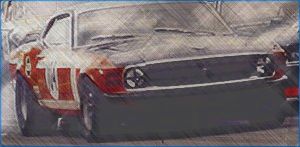
No, we had the brake system underway, but because I could get anything I wanted to from Girling, we just put the Girling system on the car because of the brake pads. My people used the DS 19 pad in those days, and its hard to recall details, because we had driven the odd car over the years.
When we went to South Africa to run the car, we were able to implement more because the regulations were reasonably loose. We went out to South Africa to do the best we could under the circumstances, and a chap called Mike de Udy i joined us. They had found some money for Michael to drive and all Michael had to do was to stay on the black strips if he wanted to be successful. He had lots of other relatives in South Africa, and they wanted some sort of identity for the Udys, because his mother came from Hazelmere in England.
They were wealthy people, you know, running into the many hundreds of millions, so Michael desperately wanted to be a driver. Up to that time his record hadnít been all that good. He had Porsches, and scratched the odd things up, and hurt himself. I wasnít interested in accidents so I spent a bit of time with him and sorted him out, and he was a good lad, he certainly had no shortage of bravery. That of course had to be curtailed because common sense had to prevail over bravery.
It was a successful tour on both occasions, as well as with the Lola we achieved good results. We won the series outright from formidable people like John Love and Tony Madson. The reigning South African champion who Love was and the Kirsten scene, they had some good people out in South Africa, really good drivers, like Paddy Driver and the Redman boys and they were all operators, they were all bloody good, a lot of them were ex motorcyclists. Gary Hocking and all those, they were all going to kill themselves soon. There was such big talents, but just a little bit over the top, and you canít live in the upper limits all the time. It was such a shame to see Redman & then Hocking.
Paddy Driver is still alive, but you know bit by bit the upper echelon of talent. John Love survived of all good things, but John Love was also a veteran of the war, and he knew a little bit about survival. Tony Madson got incinerated to the stage of bad disfigurement and became a recluse. But they were all people who treated you very well in Europe.
So the car basically complied with the local regulations, I mean with the Touring Car regulations of that era. Today you only have to go on the related web sites and go back and see what they had to comply with alongside with what they could get away with.
About carburettors? Did you run Webers?
No, no, no, we run the Holleyís and things, we were still on the old things , but we just tweaked it up. Their american sort of throttle control wasnít subtle, we did an awful lot of racing in the wet, and they (the americans) are required in the rain to bring out the flag and come into the pit, they werenít wet weather drivers. They havenít improved much, as the last Indy (Gold Coast) could see by their organization for the weather, I mean the clubs would approach the stewards and just want to get the race over. Europe was completely different.
What sort of tyres did you use back then on the car?
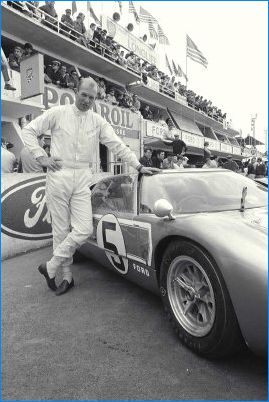
"1967 Le Mans in the GT40 was one of my highlights" says Frank Gardner
Picture courtesy Ford
I was contracted to Goodyear and was doing their tyre testing out in Luxembourg. Leo Mel was then in charge of Goodyear. Barry Griffin was their main bloke and the technical man and there was - out of America - Lee Gog. Ford used the Goodyears very much in the Ford range in the US and worldwide. We approved a tyre after a weeks testing at Luxembourg. We checked, if the noise level was satisfactory, the adhesives were good as we went on the skid pan. We've done it all with a G-meter. The critical thing was with privateers and professionals. So, when you are working with the best technicians or cheap technicians in those days.
We picked up the best tyres and made sure things were right. Goodyearís was a tyre manufacturer in those days that supported winning world championships, they had Formula One people contacted like the Brabhams, Bruce McLaren, Dan Gurneys and Denny Hulmes and these people and so we made sure they had the best.
But we would remove business of Goodyear with these privateer drivers saying Ēoh the other one's a good tyre, thatís a good tyreĒ. So all we had to do was lift the G-meter up on those other tyres, we ensured we had the directional stability then and a low noise level. But still it was very good rubber with them. So once again, the privateer had a hard time, but thereís no point. Itís like doing your work, you can work your arse off, but if you work a bit smarter, the results are a lot better. Thatís how all that lot all came about.
Editors Note: This response may have been misinterpreted from the editor of this site. We are going to reconfirm this part very soon.
About Alan Mann Racing - how did you work with him then?
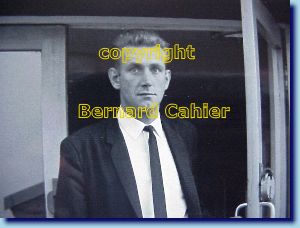
Alan Mann himself.
See also my Alan Mann Interview on this site
It was no coincidence that Alan Mann owned the hangar where our workshop was located. Alan was concentrating on his aviation business to build that lot up. At that stage I think he had about 14 helicopters, and about 12 fixed wings, and he owned Fairoaks Airfield. Well, he didnít own it, he was in partnership with the Greeks, Stavlos, and the shipping bloke, who was married to Kennedy Onassis, whom we met at Monaco, and they put on a dinner and weíd have dinner aboard Onassis yacht, and Jacqueline Kennedy would be there to welcome everybody. Iíve been kissed on the cheek by Jacqueline Kennedy, and also Princess Di. We had a ball at Monaco. I have been immortalised at Monaco because I set a lap record there and its now in gold in the automobile club, and that was of that will forever stand as they stopped that formula the next year. It was a real good time to set a track record!
The Mustang - how did it compare to the Alan Mann Falcon, the í64 Falcon Sprint that you raced the .. Championship with?
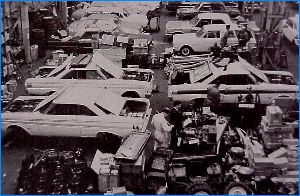
Alan Manns Rallye Falcons being prepped
(most probably at Lincoln Cars Garage)
Picture courtesy
Ford
Well, that was another car. The Falcon came to life for the simple reason that they wanted a Ford to run in the Monte Carlo rally. Then they made the Falcon a fibreglass one and you have to have 200 of them for homologation purposes. But they only ever made 50. When the French came across, those 50 were all in a hangar and they inspected them, then they went for morning tea - they all sat down and had morning tea, which was enough time to get the cars over into hangar number two, and they looked at the next 50, and then it was lunchtime, thatís the true history of the Falcon homologation.
Those were the days. At that time we finished with those cars - the regulations were not that strict, it was rather politics taking over sometimes, before its under control.
I can remember a similar case with General Motors when I looked at all the homologation stuff here (in Australia). They had to make 100 cars before they could run one at Bathurst. I think they made only 5 and won Bathurst, and nobody could get a look in, it was a bit like the Monaro that just run in the 24 hour at Bathurst, straight out race car amongst production cars.
That sort of thing had been going on, but the Falcon was more up to the road, because we knew what the regulations were then, we knew what we wanted, so the Falcon was more the race car as such, because it had a better power to weight ratio. I mean putting fibreglass panels on a motor car when you could just make a mould and make much lighter panels and get your weight down so the centre of gravity was better. You canít do that on a tin car.
As for the windscreen - we were able to get some reasonably light weight glass in and then of course we were able to do quite a lot more with the filling of the roll cage. Surf boards were just coming into vogue so we knew a few things about fillings and stuff like that. You could ignite a pretty good brew and that solidified the whole thing inside the roll cage. Where youíve got typically 3 tons of steel to make the car strong, we had it done with half the weight, and so as with all these cars it was indicated it was. Because of the loose regulations to the homologations to the Monte Carlo we were able to cash in on that. Which wasnít fair to the Mustang or the Camaros, or whatever have you to compare them to that car, because you couldíve shuffled the Mustang around to do that job had you have the freedom to do it, but the freedoms werenít there, so thatís the best you could do, at that point in time.
Lets have a short break here. Get a cup of coffee and then click here to continue.
Special thanks go to David Bowden for his time to perform, tape and his secretarys typing and again editing the interview with Frank. Some parts are subject to final confirmation with Frank due to some recording interruptions and australian/english "transfer" problems after the interview.